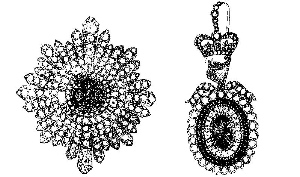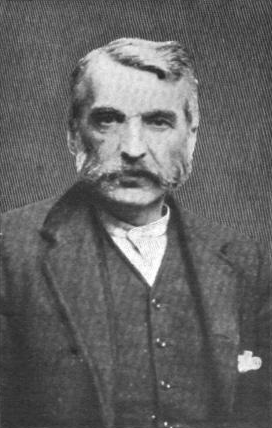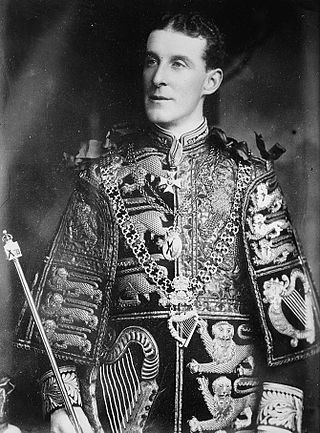
The Exploits of Elaine is a 1914 American film serial in the damsel in distress genre of The Perils of Pauline (1914).

Edmund Bernard FitzAlan-Howard, 1st Viscount FitzAlan of Derwent, known as The Honourable Edmund Fitzalan-Howard between 1855 and 1856, Lord Edmund Fitzalan-Howard between 1856 and 1876, and Lord Edmund Talbot between 1876 and 1921, was a British Conservative politician and the last Lord Lieutenant of Ireland. He was the first Roman Catholic to be appointed Lord Lieutenant of Ireland since the 17th century, holding office when Ireland was partitioned into Southern Ireland and Northern Ireland.

The Jewels Belonging to the Most Illustrious Order of Saint Patrick, commonly called the Irish Crown Jewels or State Jewels of Ireland, were the heavily jewelled star and badge regalia created in 1831 for the Sovereign and Grand Master of the Order of St Patrick, an order of knighthood established in 1783 by George III as King of Ireland to be an Irish equivalent of the English Order of the Garter and the Scottish Order of the Thistle. The British monarch was the Sovereign of the order, as monarch of Ireland until 1801 and of the United Kingdom of Great Britain and Ireland thereafter. The Lord Lieutenant of Ireland was the Grand Master in the absence of the Sovereign. The insignia were worn by the Sovereign at the investiture of new knights as members of the order, and by the Grand Master on other formal ceremonial occasions.

Brigadier-General Paul Aloysius Kenna, VC, DSO was an English-born British Army officer of Irish descent and recipient of the Victoria Cross (VC), the highest and most prestigious award for gallantry in the face of the enemy that could be awarded to British and British Empire forces. He also competed at the 1912 Summer Olympics.

Adam Worth was a crime boss and fraudster. His career in crime, stretching from the United States to Europe and South Africa, included the infamous theft of Gainsborough's celebrated Portrait of Georgiana, Duchess of Devonshire, which he retained for 25 years. In London, he lived as a respected member of high society under the alias Henry Judson Raymond. Scotland Yard Detective Robert Anderson nicknamed him "the Napoleon of the criminal world" based on his short stature. He is widely considered the inspiration for Sir Arthur Conan Doyle's fictional criminal mastermind James Moriarty in the Sherlock Holmes series.

Major Sir Nevile Rodwell Wilkinson, KCVO was a British officer of arms, British Army officer, author and a dollhouse designer.

Arthur William de Brito Savile Foljambe, 2nd Earl of Liverpool,, styled Viscount Hawkesbury between 1905 and 1907, was a British Liberal politician, the 16th and last Governor of New Zealand, and the first Governor-General of New Zealand.

Major General Sir Vernon George Waldegrave Kell, was a British Army general and the founder and first Director of the British Security Service, otherwise known as MI5. Known as K, he was described in Who's Who as "Commandant, War Department Constabulary".

A Gentleman of Leisure is a novel by P. G. Wodehouse. The basic plot first appeared in a novella, The Gem Collector, in the December 1909 issue of Ainslee's Magazine.

Sir Arthur Edward Vicars, KCVO, was a genealogist and heraldic expert. He was appointed Ulster King of Arms in 1893, but was removed from the post in 1908 following the theft of the Irish Crown Jewels in the previous year. He was murdered by the IRA in 1921 during the Irish War of Independence.

To Catch a Thief is a 1952 thriller novel by David Dodge. The scene is the French Riviera, and the time is 1951.

Colonel Sir Charles Edward Howard Vincent, known as Howard Vincent or C. E. Howard Vincent, was a British soldier, barrister, police official and Conservative Party politician who sat in the House of Commons from 1885 to 1908.

Charlie Chan in London is a 1934 American mystery film directed by Eugene Forde. The film stars Warner Oland as Charlie Chan. This is the sixth film produced by Fox with Warner Oland as the detective, and the second not to be lost, after The Black Camel (1931).

Georgina Elizabeth Ward, Countess of Dudley was a British noblewoman and a noted beauty of the Victorian era.

Sir Arthur Gorges was an English sea captain, poet, translator and courtier from Somerset.

William "Willie" Middleton Wallace was a rugby union player. He played fullback for Cambridge University RFC and was capped for Scotland in 1913–14.

Gorges Edmond Howard (1715–1786) was a miscellaneous Irish writer. He wrote on the law and created literary works.

The Gorges family was an Anglo-Norman family with lands in the southwest of England. They obtained the manors of Wraxall, Somerset and Bradpole in Dorset.

Admiral Sir Vernon Harry Stuart Haggard, KCB, CMG was a Royal Navy officer who went on to be Commander-in-Chief, America and West Indies Station. His career in the Royal Navy spanned forty-four years, from his entry as a youth in 1888 to his promotion to admiral in 1932.

The Lone Wolf in London is a 1947 American mystery crime film directed by Leslie Goodwins and starring Gerald Mohr, Nancy Saunders and Eric Blore. The picture features the fictional Scotland Yard detective the Lone Wolf who travels to London, and solves the mystery of some missing jewels. It was the penultimate Lone Wolf film, followed by The Lone Wolf and His Lady in 1949, and the last for Mohr in the lead role.




















